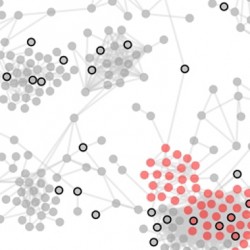 Enrico Petretto discusses brain networks and epilepsy
Enrico Petretto discusses brain networks and epilepsy
Epilepsy is the most common serious neurological disease. More than 350,000 people in the UK are affected and around a thousand people in England and Wales still die from the condition every year. Over 30% of patients are resistant to drugs, presenting a major barrier to effective epilepsy treatment. Researchers led by Enrico Petretto (Integrative Genomics and Medicine Group, MRC Clinical Sciences Centre) and Michael Johnson (Centre for Neuroscience, Imperial College London) are using the latest technology and medical insight to tackle the problem.
For a few patients with drug resistant epilepsy, surgery can be offered as a treatment for their seizures, most commonly involving surgical resection of a scarred hippocampus. Such operations have yielded human brain tissue for research. “So now we can start to look at the human genes involved in the disease,” he confirms.
“We’re focusing on brains from patients who experienced the highest frequency of seizures,” reveals Enrico, “because these are the most resistant to drug-treatment.” Understanding gene networks and pathways in individuals who don’t respond to drugs will hopefully provide new insights and potentially new angles on how to treat the disease.
“If we know how many seizures a month patients have, we can look at their brain tissue to find out which gene networks are at play.” Using the latest in microarray technology, the team gets a readout across the entire genome highlighting which genes (out of the 25,000 or so human genes) are switched on in the brain cells under investigation, and how active (highly expressed) these are in diseased tissue.
“We found around 300 genes that are associated with seizure frequency,” Enrico reveals. “Within this subset there is a large number of Toll-like receptor signalling genes.” These genes are known to be involved in the body’s immune responses, regulating processes such as inflammation, for example.
But the team needed to find out which genes in the large network of interconnected genes (~500) correlated with seizure frequency. “The candidates should be more active in brain tissue from individuals that have very frequent seizures,” confirms Enrico, “but lower in the brains of individuals who experience seizures less often.” And 77 genes fit that bill.
In order for any of these genes to be drug targets, they need to be ‘druggable’. Assessing the druggability of any gene requires looking at how it works with other genes in the network. Drugs that target genes that work in tandem with lots of other genes can result in unwanted side effects. “So we need to identify these ‘hubs’,” explains Enrico, “…genes at the centre of the network, which are connected to many other genes.”
The research team applied a statistical algorithm to extract and then visualize all network hubs. “We can portray genes using nodes of different sizes to represent the ‘connectedness’ of genes,” he says. “The bigger the node, the more genes it affects.” In this way, the researchers whittled the list down to seven key genes, several of which are involved in systems that facilitate communication between cells.
“One of these, is a potential drug target,” reveals Enrico. The gene identified plays a role in memory and cognition in the brain and from mouse models’, it has been shown that blocking this inflammatory pathway successfully reduces seizures.”
Enrico adds, “our research using novel systems-level approaches is beginning to point to new therapeutic targets for epilepsy.This is the first research of its kind to be conducted on human tissue and Michael and I are at the forefront of this approach. No doubt, with the powerful tools now at scientists’ disposal, it must only be a matter of time before new and better treatments for epilepsy are developed.”
BM
